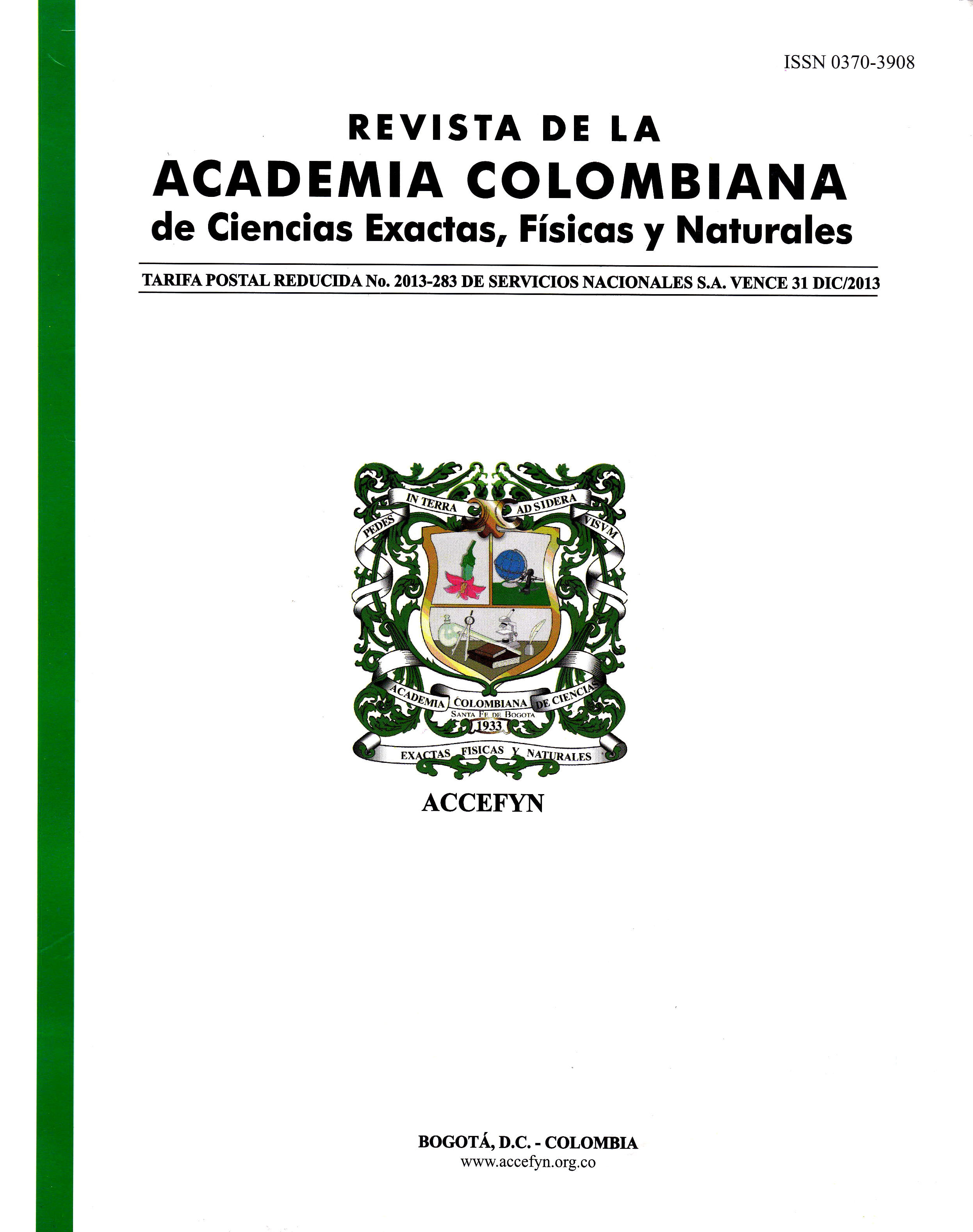Resumen
Usando medidas de espectroscopia de impedancias en el rango de las radiofrecuencias en dos tipos de conductores protónicos con estructuras desordenadas, cristales iónicos con enlaces de hidrógeno desordenados (MH2PO4, M = NH4, K) y polímeros sólidos basados en poli alcohol de vinilo (PVOH), se ha investigado la dinámica de protones. Se encuentra que obedecen a similares características en los espectros de la conductividad, permitividad y módulo eléctrico complejos. En efecto, muestran una activación térmica de la conductividad tipo Arrhenius; sus conductividades son descritas a altas frecuencias (ω/2
Referencias
Baranov A.I., Shuvalou L.A., Schagina N.M. (1982). Superionic conductivity and phase transitions in CsHSO4 and CsHSeO4. Journal of Experimental and Theoretical Physics Letters 36:459-462.
Castillo J., Chacón M., Castillo R., Vargas R. A., Bueno P. R. , Varela J. A. 2009. Dielectric relaxation and dc conductivityon the PVOHCF 3COONH4 polymer system.Ionics15: 537-544.
Castillo R. 2012. Estudio de relajación dieléctrica en cristales mixtos de (NH4)1-xKxH2PO4. Tesis de doctorado en Ciencias-Física, Universidad del Valle.
Checa O., Diosa J.E., Vargas R.A., Santamaría J. 2009. Dielectric relaxation of CsHSeO4 above room temperature.Solid State Ionics 180:673-676.
Cheng X., Shi Z., Glass N., Zhang L., Zhang J., Song D., Liu Z.-S., Wang H., Shen J. 2007. A review of PEM hydrogen fuel cell contamination: Impacts, mechanism and mitigation”. Journal of Power Sources 165: 739-756.
Diosa J. E., Vargas R.A., Albinsson I., Mellander B. E.2004. Dielectric relaxation in single crystal NH4H2PO4 in the high-temperature regime. Solid State Communications132: 55-58.
Diosa J. E., Vargas R.A., Albinsson I., Mellander B. E. 2005.Dielectric relaxation of KHSO4 above room temperature.Solid State Ionics 176:2913-2916.
Diosa J. E., Vargas R.A., Albinsson I., Mellander B. E. 2006. Dielectric relaxation in NH4HSO4 above room temperature.Solid State Ionics177: 1107-1110.
Fernández M.E., Delgado I., Diosa J.E. , Vargas R.A. 2005. Thermal and transport properties of the polymer electrolyte base donpoly(vinyl alcohol)-LiOH-H2O. phys. stat sol. (c) 2: 3738-3741.
FunkeK..Banhatti R.D. 2006.Ionic motion in materials withdisordered structure. Soli State Ionics 177: 1551-1557.
Goñi-Urtiaga A., Presvytes D., Scott K. (2012). Solids acids as electrolytes materials for proton exchange membrane (PEM) electrolysis: Review. International Journal of Hydrogen Energy 37: 3358-3372.
Hasani-Sadrabadi M. M., Ghaffarian S. R., Mokarram-Dorri N., Dashtimoghadama E., Majedi F. S. 2009.Characterization of Nanohybrid membranes for direct methanol fuel cell applications”. Solid State Ionics 180: 1497-1504.
Jiang S., Lin S., Feng W. (2011). Journal of the Mechanical Behavior of Biomedical Materials 4:1228-1233.
Jonscher A. K. (1966). Universal Relaxation Law. Chelsea Dilectrics Press, London.
Jurado J.F., García A., Vargas R.A. 2000. High Temperature phase transition in K1-x(NH4)xH2PO4. Solid Stae Ionics 136-137: 985-989.
Kreuer K.-D. 1996. Proton conductivity: Materials and Applications. Chemistry of Materials 8:610-641.
Kusoglu A., Karlsson A.M., Santare M. H. (2010). Structure property relationship in ionomer membranes. Polymer 51: 1457-1464.
Lee B.Y., Kim J-K., Kim J-Su., Kim Y.Y. (2009). Quantitave evaluation technique of polyvinyl alcohol (PVOH) fiber dispersion in ingineeredcementius composites. Cement and Concrete Composite 31:408-417.
Lee K-S. (1996). Hidden nature of high- temperature phase transitions on crtistals of KH2PO4- type: is it a physical change? Journal of Physico Chemical Solids 57: 333-342-.
Matosa B.R., Santiago E.I., Reyb J.F.Q., Ferlautoc A.S., Traversad E., Linardia M., Fonseca F.C. 2011.Nafion based composite elecfion based composite elecon-based composite electrolytes for proton exchange membrane fuel cells operating above 120°C with titania nanoparticles and nanotubes as fillers .Jorunal of Power Sources 196: 1061-1068.
Morita M., Noborio H., Yoshimoto N., Ishikawa M. 2006.Ionic conductance of composite electrolytes based on network polymer with ceramic powder”. Solid State Ionics 177: 715-720.
Norby T. (1999). Solid-state proton conductors: principles, properties, progress and prospects. Solid StateIonics125: 1-11.
Palacios I., Castillo R., Vargas R. A. 2003. Thermal and transport proper-Thermal and transport properties of the polymer electrolyte based on poly(vinyl alcohol)/KOH/H2O. ElectrochimicaActa48: 2195-2199.
Peighambardoust S.J., Rowshanzamir S., Amjadi M. 2010. Review of the proton exchange membranes for fuel cell applications. International Journal of Hydrogen 35: 9343-9384.
Ram S., Mandal T. K. 2004. Photoluminescence in small isotactic, atactic and syndiotactic PVA polymer molecules in water.Chemicla Physics 303: 121-128.
Rivera A. Santamaría J. and León C. (2001). Electrictrical conductivity relaxation in thin�film ytria�stabizad zirconia. Applied Physics Letters 78: 610-612
Smolinka T. 2009.Encyclopedia of Electrochemical Power Sources. Freiburg, Germany: Institute for Solar Energy Systems USE, pp 394-400.
Vargas M. A., Vargas R. A., Mellander B-E. 1999. New Proton Conducting Membranes based on PVAL/H3PO2/H2O”. Electrochimica Acta 44: 4227-4232.
Vargas M. A., Vargas R. A., Mellander B-E. 2000. More studies on PVAL+H3PO2+H2O proton conductor gels”. Electrochimica Acta 45:1399-1403.
Vargas R. A., Zapata V.H., Matallana E. and Vargas M.A. 2001. More thermal studies on the PVAL+H3PO2+H2O solid proton conductor gels.Electrochimica Acta 46: 1699-1702
Vargas R.A., Bedoya F., Castillo J. E., Rodríguez L. A. andChacón M.2011.Mechanical Relaxation in polymer electrolyte membranes based on PVOH-H3PO2-ZrO2. Journal of Nanostructured Polymers and Nanocomposites6/3: 87-92.
Wan X., Yucel T., Lu Q., Hu X., Kaplan D-L.(2010). Silk nanosphere and microsphere from silk/PVOH blend films for drug delivery. Biomaterials 31:1025-1035.
YangC.-C, Wu G.M. 2009.Study of microporous PVA/PVC composite polymer membrane and if application to MnO2 Capacitors”. Materials Chemistry and Physics 114: 948-955.
YangC.-C.2007. Synthesis and characterization of the cross-linked PVA/TiO2 composite polymer membrane for alkaline DMFC”. Journal of Membrane Science 288: 51-60.
YangC.-C., Lin C.-T., Chiu S.-J.2008. Preparation of the PVA/HAP composite polymer membrane for alkaline DMFC application”.Desalini sation233 (2008) 137-146.
Yang C-C.(2006). Study of alkaline nanocomponent polymer electrolytes based on PVA-ZrO2-KOH.Materials Science and Engineering B 131:256-262.
Yang C-C.(2007). Synthesis and characterization of the cross-linked PVA/TiO2 composite polymer membrane for alkaline DMFC. Journal of Membrane Science 288:51-60.
Yuan X.-Z., Li H., Zhang S., Martin J., Wang H. 2011. A review of polymer electrolyte membrane fuel cell durability test protocols.Journal of Power Sources 196: 9107– 9116.
Zapata V.H., Castro W.A., Vargas R.A., Mellander B.-E. 2007. More studies on the PVOH–LiH2PO4 polymer system. Electrochimica Acta 53: 1476–1480.

Esta obra está bajo una licencia internacional Creative Commons Atribución-NoComercial-SinDerivadas 4.0.
Derechos de autor 2023 Revista de la Academia Colombiana de Ciencias Exactas, Físicas y Naturales

